#georgette mademoiselle
Text

Georgette and sekido part 8
overthinking
This one is kinda a continuation to the last one i made yesterday
Even since the beginning of there first encounter she had always tried to keep away from him because he was very intimidating but after finally bieng alone to talk to him that fateful day there relationship started to slowly develop from there but would revert back when his anger got the best of him towards her accidentally.
But on this particular day she was avoiding him for a week now and soon his rage would dwell into fear he thought he was going to lose her for good and choose to be with the others instead of him permanently.
He was in his working station in his room mot even able to concentrate as he fidgets around his pen while the other massages his temple his leg making the same movement as his working hand he was nervous more so that his beloved could possibly be thinking to leave him now because he went to far in his words.
He may be the embodiment of anger but still shares the same anxiety as hantengu just not to that extreme. Soon his chest almost felt tight and suddenly hes gulping down his weakness near the edge of wanting to have a paranoid breakdown never in his life has he felt such guilt for his actions not like this hes not used to this feeling at all and it only agitates him more that hes in this vulnerable state of despair and shame.
But then the door slides open he had forgotten to lock it. it was georgette, she had come to check up on him after never leaving his room all day today sne was worried for his well-being but before she could even say anything something was already wrong by the shaking body gesture and hands clutched onto his head "sekido!" She called.
Immideatly he jolted to her way. His eyes where wide in fear and it looked as if he was fighting back tears seeing the glisten of his eyes while sweating. His panick attack was about to hit full blown but her presence and look of genuine concern blocked it from happening.
"g-gerogie..." Just before she could move towards him with open arms sekido jumped out of his seat to hold her missing her warmth her gentlness her scent everything about this woman he missed it all. Wrapping his arms around her waist before he fell to his knees the wetness of her dress as he silently sobs of relief.
"sekido! Sekido! Hey whats wrong? My thunder storm why do you weep?" She kneels down letting him rest upon her lap as he lets it all out fingers caressing his soft auborn colored hair.
His words took time to put together, pulling together to stop from hyperventilating until finally words managed to escape his mouth.
" i-i-...im sorry! Ok there! Sorry! I know im not the kindest of person in the world infact i dont even deserve to be treated with such gesture! Y-you deserve better ok! Go with ai hes more empathetic o-or urogi! He can make you smile! Even stupid karaku would be better of with you! J-just...*fighting the urge not to cry again* anyone but me ok! I dont want to hurt you like that ever again I'm sorry georgie im so sorry!...."
She sat there and listened to his woes, she had no idea that he would have been affected by her absence, she only wanted to give him room to breath no matter how long it taked but that wasnt the case sekido missed her since day one of leaving him alone and now his guilt took a toll on him that she would leave him for somone else somone better and kinder. Yet little did sekido know he was kind a very different kind of kindness that was rare to see.
" my love, why do you say such nonsense? I already have the most kindest most understanding man right her on my lap." She moves her other hand to rub his shoulder.
" your motherly nature when you look out for your comrades is something i admire, perhaps strict but nonetheless its because you care for there safety"
" and dont think ive forgotten the time when you nurtured me during the time i came home with my face disfigured you still complimented me thoughtful after i was feeling low self esteem in that moment and to top it off you even came to my care when i was sick due to my ability even though you didnt have to. i think about it often "she chuckles placing a kiss on his forhead.
" you are loved sekido, and you are wanted. Nobody is perfect and thats ok...im not eather. No matter how rocky our relationship gets i want us to be able to solve it together because at the end of the day while i love the other three i want to be with *you* more than anyone sekido.."
He listened and the more he did the more he was gaining his composure again. He needed to hear that this was something hes been needing to hear for a long time now. Hes flawed and thats ok she is aswell. As his worries finally drift away sekido finally had the courage to slowly lift himself up to her nuzzling on the crook of her neck the same she did to him during that day of her mental breakdown.
"thank you, my rose..."
"i really needed to hear that..." He deeply sighed feeling true relaxation now.
" i think if you hadnt had come here any time i would have already bashed my head againts the wall along with the other idiots."
She only laughed
" where going to have to work on a different approach for a better anger management for example"
Hands him a rubber stress ball "tada!'
"....what the fuck is that?'" he looked at it with disgust the texture feeling wrong to him
" a stress management ball you can squeeze it throw it and smash it to let your anger all out see? Im good at this!"
He just stares at it and then clutches it with his fists then snorts.
" well this sure looks fun.."
"because it is my little lightning bolt ❤️"
Dividers by @/elryisia

#i like to think sekido is self conscious about his constant state of anger especially if its somone he deeply cares about it#it makes him feel that there better of finding somone else instead#sekido x georgette#georgette mademoiselle#original demon oc#kinda but not really kny oc#sekido#kny sekido#sekido kny#upper moon 4#hantengu clones#kny#demon slayer#kimitsu no yaiba
23 notes
·
View notes
Text

@georgette-mademoiselle, look, it's Georgette.
16 notes
·
View notes
Text
Good evening everyone.
I'm here to announce that I'll be taking a break from tumblr for 3 days to recover from this ordeal we all had.
I've been feeling a bit suicidal over what has been happening and how it affected all of you because of one person who has now been banned. I'm sorry to those who have been a victim of oc x canon hate. Mostly from this Sakura person.
I wanted to thank you to those who have been siding with me and standing up to others who where also targeted by this person.
I'm glad that I made friends with many of you and knowing that we protect each other from something like this made me feel welcome on tumblr.
Tagging: @mylou-doodlesworld @urog1i @aliorailrow @bugzheadquarter @rion-isnot-an-ai @your-local-demon-slayer-nerd @axolotl321 @serenesaku @tobytoon @kimetsu-chan @starrcityyy @night-mince0 @leviathanverse @georgette-mademoiselle @starsinthesworld @cherrybomb-xoy @larz-barz @muichiroslovermwah @ta-ni-ya @kiyokatokito @risingscorchingsuns @fallstreakfeathers @saffron0v0 @hantenguclonesimp-minuszoha @1julak1 @wifeyana and @hashbrowpn and @haruharuna [It doesn't let me type your user in. Sorry about that.]
And thank you @sunbrokenswords and @bloodbladesanddemons for following me. You two are my favorites. And I am sorry about what that anon had said to you Blood. Don't listen to them. Do what makes you and your friends happy.
And as promise, here is the Karaku x Uranishi art before my 3 days departure. Them as humans. :>

"Daisy, Daisy,
Give me your answer, do!
I'm half crazy,
All for the love of you!
It won't be a stylish marriage,
I can't afford a carriage,
But you'll look sweet upon the seat
Of a bicycle built for two!"
#demon slayer#karaku#kimestu no yaiba#hantengu clones#kimetsu no yaiba#demon slayer karaku#demon slayer oc#karaku x oc#kimetsu no yaiba original character#demon slayer original character#kny oc#kny oc art
71 notes
·
View notes
Text
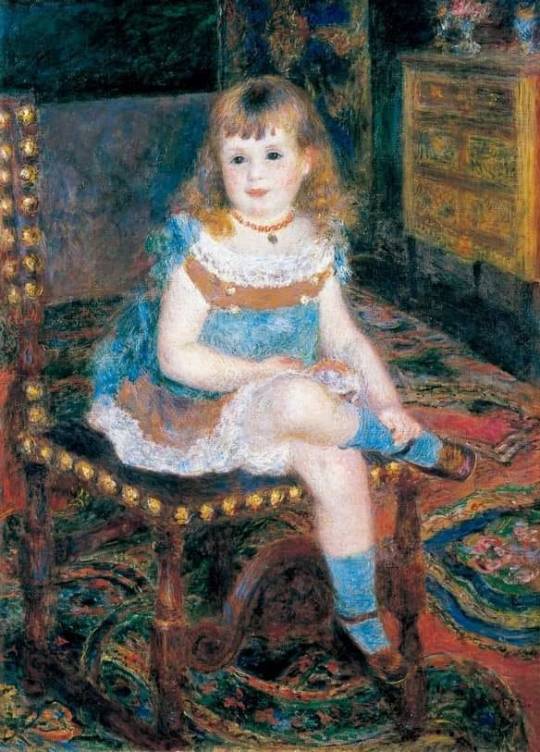
"Mademoiselle Georgette Charpentier Seated" by Pierre-Auguste Renoir.
2 notes
·
View notes
Text
Smut4Smut 2023: And At First Meeting Loved
AO3
My Mysterious Mademoiselle, Uncle George/George Jr., 8k, Explicit
Tags: Victorian, POV First Person, Explicit Sexual Content, Crossdressing, Oral Sex, Anal, Fingering, Anal Sex, Uncle/Nephew Incest, Incest, Romance, From Sex to Love
A holiday at Deauville with a beautiful wife.
Second time writing for MMM! I definitely need to give it a break for a while, but it’s a great canon. Meta ramblings about the fic below the cut.
The title is taken from Abraham Solomon’s paintings of a first-class Victorian train coach. There’s two versions, because the first was so controversial for showing an unchaperoned lady talking to a strange man. It’s a very apt comparison point for George and George Jr., who, after all, meet when Jr. is pretending to be an unchaperoned young lady on the train!
Sleeping Chaperone
The revision
I adore the title of these paintings. “And at first meeting loved.” That’s the feeling I get from the original short story, George Jr. disguising himself to get a measure of this unmet foreign uncle and finding himself helplessly infatuated from the start. It’s why this ship appeals to me so much!
I’m not particularly predisposed to incest ships. They’re fine, just not usually what grabs my attention. However, I love reunions as a trope: characters who have never met but have some existing relationship, or who haven’t seen each other in many years, coming back together and falling in love is my thing. An incest ship can grab me if, like this one, it offers a chance at a reunion. Georges Vane are indelibly family, through a sister/mother, and so their meeting in My Mysterious Mademoiselle lands to me like a reunion rather than a first encounter. They ultimately bond over their love of this shared family member. Young George being struck by how caring, and protective his uncle turns out to be is a wonderful opening to believe that he might develop a fancy—and it helps that Uncle George isn’t shy about describing himself as handsome and romantically successful. The story is so light (frothy!) that the age gap and incestuous nature of the pairing don’t feel like heavy topics that one must address in order to have a serious focus on the romance of the ship. At least to me, I should disclaim.
I think there is a version of this ship which kinks more readily on the uncle/nephew part or the age gap. I mean only that, as those aren’t my kinks, this is a canon which makes it shockingly easy to focus on other kinks. Quite probably that’s because of the crossdressing, which can amply fill any space you give it. George Jr. wears a dress like nobody else, and I was so glad that @sheeon requested “receiving a blowjob while wearing a dress” as a kink. My god. Yes, of course. A natural pairing. But I also gave Jr. a frilly little nightgown, and obviously he had to have stays, and a bustle, and a shawl and a wig. Crossdressing is a kink that I love, and more than that, historical dress is another one of my hobbies. George Jr. is just so happy to be subversive in everything that he touches that as an author, I can show that subversion through crossdressing and (in)appropriate public behavior rather than things I might prefer less.
So when it comes to the relationship dynamic between the two Georges, my interests lie in the tension between practical, stolid, English Uncle George and romantic, impetuous, French George Jr. They adore one another. Their fondness shines off of the page. I do what I can to capture that in my own writing, and I think I’ve mostly been successful, but it is fully to the credit of the original. George Jr. would legally become Mlle. Georgette and marry her Uncle in an instant, but Uncle George can’t reconcile a solution like that with the damage he feels it would do to George Jr.’s life: his social prospects, his career, his ability to move through the world freely. The first time I wrote them, George Jr. was younger, his mother had died from her illness, and Uncle George’s focus was on getting his nephew through school and resisting the come-ons entirely. That was a lot of fun, but I didn’t want to repeat the “First Time” trope again—it’s a natural thought for the ship, just not something I wanted to belabor in such quick succession. Taking on an established casual-sex relationship and asking how it would transition to full romantic commitment was much harder. In the first story, romance and sex can happen together! In this, I needed to build up Uncle George’s doubt that anything between them had a chance at lasting so as to motivate why someone who had already been fucking his nephew for years might balk at the comparatively-small hurdle of professed romantic commitment.
As I type that, I wonder if I’ve written the dreaded miscommunication plot. Not quite, I think; they never had communicated about this in straightforward terms, as Uncle George refused it and George Jr. most likely tried to sneak it in the back (lol).
Some other things I love in this ship:
George Jr.’s independence! I can never make him sexually monogamous before he has a romantic commitment from his uncle. It’s a key part of what makes this relationship feel relatively equitable to me, despite the age gap—the younger George isn’t discovering either sex or romance purely through this relationship. He won’t sit around and pine idly. He pines quite actively while fucking other men! And nonetheless, he is petty and jealous about all of Uncle George’s other partners. <3
The romance! These two are so romantic. They just adore one another with Big Feelings about every single thing the other does, whether that manifests as dramatic sulks or late-night mooning over one’s nephew’s pretty face or soppy declarations after making love. I’m into shipping to feel giddy about how much two characters love each other, and that really fits the tone of this canon.
5 notes
·
View notes
Text
Hélène Guinepied , conocida como Helguy (1883-1937) pintora y profesora francesa.

Nació en Brinon-sur-Beuvronen el departamento de Nièvre, hija de Berthe Ferrier y Léon Guignepied, notario.
A los 11 años ingresó como interna en las Ursulinas de Nevers. En 1904, Hélène tomó lecciones gratuitas de dibujo en la Société d'Enseignement Moderne, una asociación filantrópica creada en 1884 en París por Léopold Bellan; Su maestro fue el pintor Jules Adler que tendría un profundo impacto en su carrera como artista.
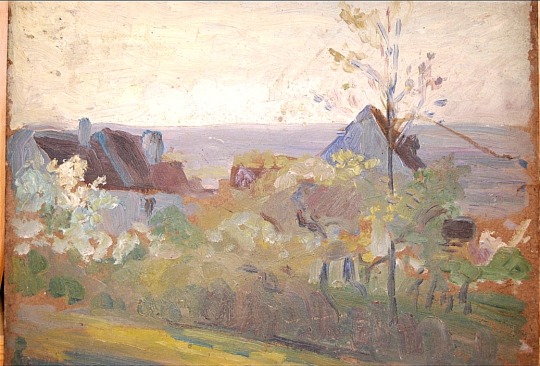
Las primeras pinturas de Hélène Guinepied se inspiraron en las pinturas y temas de su maestro: la vida de los trabajadores, hombres y mujeres en el trabajo. Después de tomar lecciones de dibujo en la Académie Julian, fue admitida en la École des Beaux-Arts de París en 1909.
De 1911 a 1913 expuso en el Salon des Artistes Français y luego en el Salon des Indépendants.

En 1916, su hermano mayor, Paul, compró el castillo de Saint-Moré en Yonne. Divide su tiempo entre París y Saint-Moré, dibuja ilustraciones para la revista Pages Médicales et Parisiennes e imparte clases de dibujo.
En 1917, Hélène tenía entre sus alumnos a Georgette, la hermana mayor del pintor y poeta, Gaston Chaissac, quien escribió en 1951: "Aún recuerdo la primera lección de dibujo que Mademoiselle Guinepied dio a mi hermana mayor y durante la cual se prohibió la goma de borrar porque tenían que hacerlo bien la primera vez” .

La artista que dice ser una “pintora rústica moderna” la reconocerá como su “instigadora del art brut” , donde el trazo negro en tinta china enseñado por el Método Helguy se convertirá en un pilar del registro pictórico que comparte con Jean Dubuffet . Este último también siguió algunos cursos impartidos por Hélène, durante sus vacaciones en Saint-Moré en 1919.

A partir de la década de 1920, las escenas acuáticas constituyeron la mayoría de las obras creadas por Hélène, que prefirió la tinta china para su creación. Estructura sus clases de dibujo e inventa un método para niños que llama Método Helguy y que animará a George Moreau, codirector de las ediciones Larousse, miembro del Consejo Superior de Bellas Artes. Proporcionó a Hélène un taller en la sede de la asociación Enfance et Jeunesse que él creó, en París.
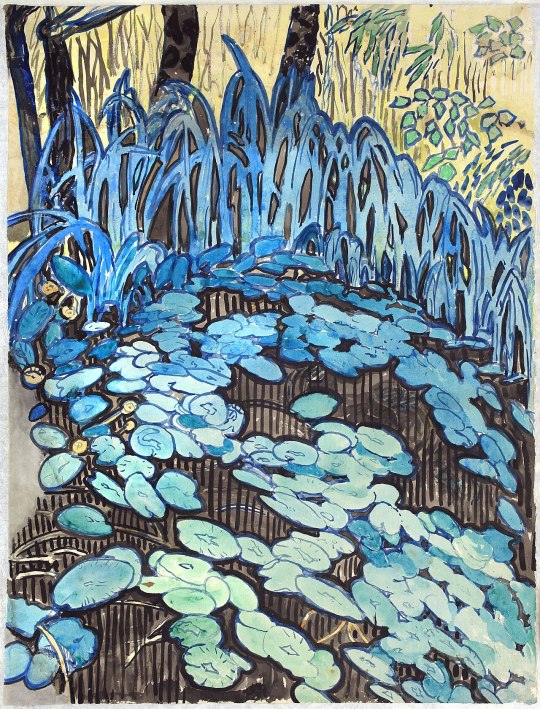
Hélène Guinepied también creó talleres de bordado, los Ateliers Villageois.
Expuso en varios lugares de Francia durante los años 1920: en Rennes para la exposición de artes aplicadas de 1922, en la Exposición Internacional de Bayona-Biarritz de 1923 donde ganó la medalla bermellón por los bordados de su Village. Talleres, en la 15.ª feria de París, y en la Exposición de Bellas Artes de Nevers y Auxerre.
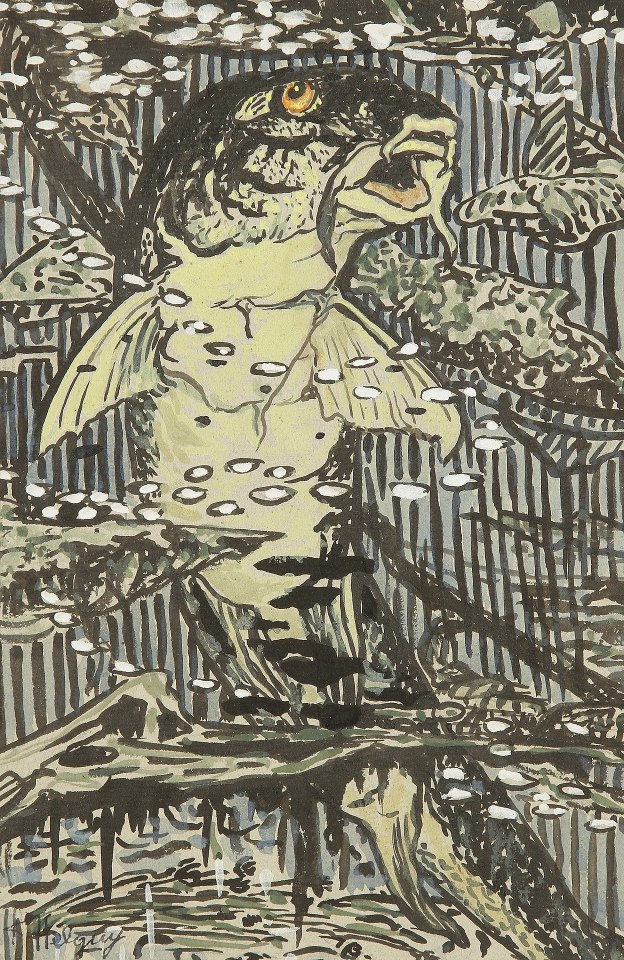
En 1929, debilitada por una enfermedad pulmonar y por la crisis financiera, Hélène tuvo dificultades para afrontar el despido de sus trabajadores, pero el periódico L'Illustration elogió su enseñanza y la revista l'Éducation dedicó un número especial al método Helguy.
En 1930 se quedó en Hossegor con la pintora Suzanne Labatut, donde pintó una serie de olas y planeó abrir un estudio gratuito con Jules Adler y Henri Za.

Con una salud frágil, murió a la edad de 54 años. Murió en Saint-Moré en el departamento de Yonne. Luego cayó en el olvido.
Sus obras que permanecieron en el castillo familiar fueron dispersadas durante una subasta en 1995. Otras acabaron destruidas en el incendio del local de su dueño. Otras fueron robadas, destruidas, mal conservadas, desaparecidas...
Este boceto fue destruido en el incendio 😔

Le ponemos cara. Hélène Guinepied en la Académie Julian en 1909.

0 notes
Text
Countess Potocka curtsies out, Mademoiselle Ducrest curtsies in
Countess Potocka takes a bow, at least for the time being. There are too many other authors I want to feature. After this extract from her memoirs, I will introduce another.
The episode with Marshal Davout's partridges is not the first appearance of the Davout couple in the Countess's memoirs. Here is how she introduced this twosome in her memoirs. Do note how warmly she smiles on young Anatole, the scion of an old and illustrious noble family, Gascon as it might be.
La maréchale (1), d'une beauté sévère, était une femme de mérite. Elevée chez madame Campan, elle y avait pris des manières distinguées, ainsi que le ton de la bonne compagnie qui manquait à son mari ; mais elle ne sut pas se faire aimer, car elle était peu amène. On la disait préoccupée de la jalousie incessante que lui donnaient les amours fugitifs du maréchal, qui, ainsi que tous les Français, raffolait des Polonaises et semblait gêné de la présence de sa femme ; car il avait, de plus, une Française qu'on prétendait ressembler trait pour trait à la maréchale et qui, grâce à ses légitimes dehors, avait suivi l'armée, au grand déplaisir de l'Empereur.
Toutes ces circonstances réunies firent que madame la duchesse s'occupa fort peu de rendre sa maison agréable, et que son époux alla chercher des distractions ailleurs.
L'état-major du général n'abondait pas en individus distingués. M. Anatole de Montesquiou (2), fort jeune alors, fut le seul des aides de camp que nous vîmes avec plaisir ; son éducation répondait à son nom.
(1) Aimée Leclerc, soeur du général Leclerc, premier mari de Pauline Bonaparte.
(2) Ambroise-Anatole-Augustin de Montersquiou-Fezenzac, 1788-1867. Il servit tout à tour Napoléon et la maison d'Orléans. Anatole de Monterquiou était poète et auteur dramatique.
The Maréchale (1), austerely beautiful, was a woman of merit. She had been a pensioner of Madame Campan's school, where she had acquired refined ways, as well as the manners of polite society which her husband lacked; but she did not become well-liked, for she was not very amiable. She was said to be prey to constant jealousy because of the Marshal's fleeting love affairs, he who, like all Frenchmen, was infatuated with Polish women and seemed bothered by his wife's presence; for he had brought with him, moreover, a Frenchwoman who was said to be the very image of the Maréchale , and who, thanks to her appearance of a legitimate status, had followed the army, to the great displeasure of the Emperor.
The combination of all these circumstances meant that Madame la Duchesse put very little care into making her domestic establishment pleasant, and that her husband went to seek his amusements elsewhere.
The general's staff did not abound in distinguished individuals. M. Anatole de Montesquiou (2), who was very young at the time, was the only one of the aides-de-camp whom we saw with pleasure; his education was a match for his name.
(1) Aimée Leclerc, sister of General Leclerc, first husband of Pauline Bonaparte.
(2) Ambroise-Anatole-Augustin de Montersquiou-Fezenzac, 1788-1867. He served both Napoleon and the House of Orleans. Anatole de Monterquiou was a poet and playwright.
https://gallica.bnf.fr/ark:/12148/bpt6k5463019n/f203.item, pp. 161-162, Note 2 p. 188
And now for another memoirist I want to introduce: Georgette Ducrest, the daughter of a fairly high-born nobleman who emigrated to England during the Revolution and who found himself uttely ruined by it. Mademoiselle Ducrest and her mother were invited by the divorced Josephine to join her in her chateau in Normandy in the winter of 1810-1811 (Joséphine having been asked to keep some distance away from Paris for a while after Napoleon's second marriage). At the time, I believe, Georgette had just barely turned nineteen. Starting in early December 1810, she and her mother spent five or six months with Josephine, but eventually made themselves unwelcome and were gradually excluded from Josephine's entourage when she returned to Malmaison in the spring of 1811. Georgette Ducrest is not so acidic as the Countess, but she has her moments. Here is her own portrait of Aimée Davout, in quite another tone:
Je revis à la Malmaison une personne avec laquelle je m'étais trouvée en relation assez intime avant son mariage ; j'en conservais le plus doux souvenir : c'était Mlle Aimée Leclerc, devenue princesse d'Eckmühl. La haute fortune où elle était parvenue n'avait, disait-on, rien changé aux agréments de son aimable caractère. Belle comme un ange, elle était simple, modeste, indulgente. Ces qualités, qui la faisaient chérir quand elle était obscure et pauvre, charmaient encore en elle, après une élévation que tout le monde trouvait une justice de la Providence.
L'impératrice l'affectionnait particulièrement, et la reçut avec tous les témoignages de l'estime la plus grande. Lorsqu'elle fut partie, Sa Majesté fit d'elle un éloge qui eût pu sembler exagéré, si la franchise de Joséphine n'avait été connue.
At Malmaison, I saw again a person with whom I had had a rather close friendship before her marriage; I had the sweetest recollections of her: it was Mademoiselle Aimée Leclerc, who had become Princess of Eckmühl. The high status she had reached had not, it was said, changed anything in the attractiveness of her charming character. As beautiful as an angel, she was simple, modest and lenient. These qualities, which made her cherished when she was obscure and poor, were still enchanting after an ascendance which was considered by all to be the just result of Providence.
The Empress was particularly fond of her, and treated her with the highest consideration. After the Princess had left, Her Majesty praised her in a way which might have seemed exaggerated, had Josephine not been known for her truthfulness.
Ducrest, Georgette: Mémoires sur l’impératrice Joséphine. Mercure de France, 2004, p. 252
This is also available online. I will provide the link in my next instalment.
Here is my aside about la franchise de Joséphine. I have this intuition that Josephine did not let hard, cold facts stand in the way of telling a story in a more interesting way. I know Aimée Leclerc was married to Davout in a most hurried way. I'm not sure it happened quite the way Josephine tells it. Maybe this will be for a future post, but Mademoiselle Ducrest has other episodes to narrate. A post in the near future will be about her impressions of Eugène.
21 notes
·
View notes
Photo
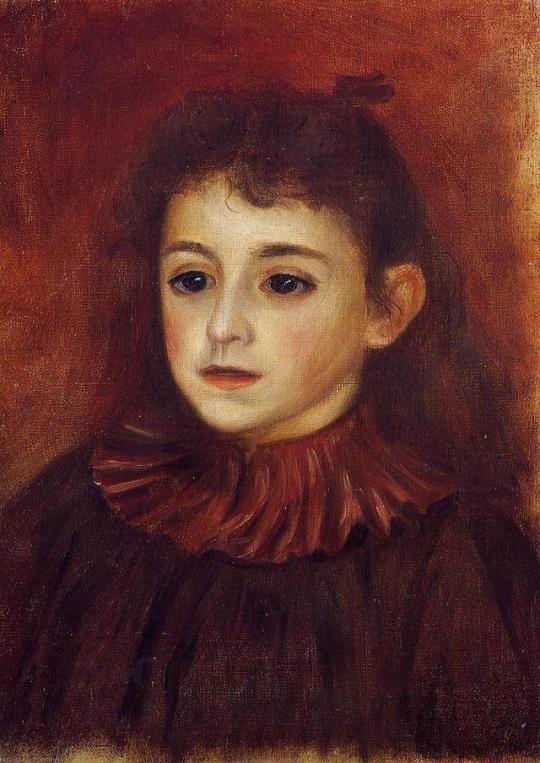
Mademoiselle Georgette Charpentier, 1878, Pierre-Auguste Renoir
Medium: oil,canvas
7 notes
·
View notes
Text
Drame conjugal sur fond de lutte des classes, le film de Gilles Grangier contribue au renouvellement du registre de Gabin, deux ans après le succès de Touchez pas au grisbi. Adapté du roman magistral de Georges Simenon “Le Fils Cardinaud”, il livre un portrait sans concession d’une certaine bourgeoisie de province.
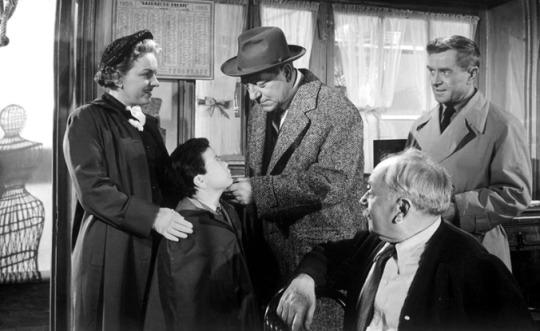
LE SANG À LA TÊTE – Gilles Grangier (1956) avec Jean Gabin, Renée Faure, Paul Frankeur, Monique Mélinand, Claude Sylvain, Henri Crémieux, Georgette Anys et José Quaglio
Il est toujours surprenant de constater comme un acteur peut se voir réduit à un certain type de rôles. Concernant le héros du Sang à la tête, il y aurait ainsi un Gabin d’avant-guerre abonné aux personnages de rebelles (La Bandera, Quai des Brumes, La Grande illusion… ). Puis, à partir des années 50, un dur à cuire inexorable, qu’il soit truand (Touchez pas au grisbi), policier (Maigret) ou capitaine d’industrie (Les Grandes familles).

LE SANG À LA TÊTE – Gilles Grangier (1956) avec Jean Gabin, Renée Faure, Paul Frankeur, Monique Mélinand, Claude Sylvain, Henri Crémieux, Georgette Anys et José Quaglio
Pourtant, si l’on considère ne serait-ce que les films de Gabin sortis en 1956, on constate à quel point sa palette était bien plus diversifiée. Sous la direction de Julien Duvivier, l’acteur commence par explorer le film noir avec Voici le temps des assassins, dans lequel il incarne le patron d’un restaurant parisien à la mode. Le Sang à la tête lui donne ensuite l’occasion de se couler dans la peau d’un armateur de La Rochelle, avant que Claude Autant-Lara ne s’amuse à casser l’image positive du comédien dans La Traversée de Paris : peintre qu’on qualifierait aujourd’hui d'”anar de droite”, Grandgil passe une partie du film à se répandre en ignominies, sur la nature humaine. Si le commissaire qu’incarne ensuite Gabin dans Crime et châtiment correspond davantage à ce que le public attend de lui, il n’en ira pas de même du médecin progressiste dépeint par Jean-Paul Le Chanois dans Le Cas du Docteur Laurent, film que l’acteur tourne à la fin de 1956. Mais une telle diversité ne peut sans doute résister au passage du temps, et ce sont les rôles les plus marquants de Gabin qu’ont aujourd’hui en tête les cinéphiles… [Collection Gabin – Eric Quéméré – mars 2006]
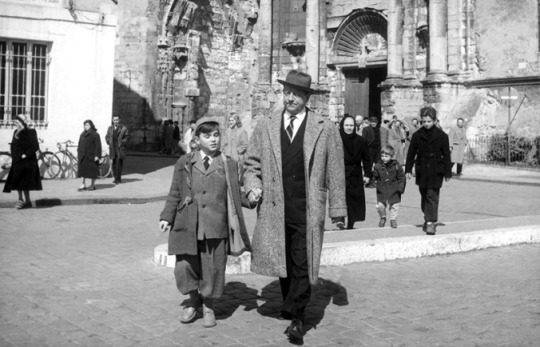
LE SANG À LA TÊTE – Gilles Grangier (1956) avec Jean Gabin, Renée Faure, Paul Frankeur, Monique Mélinand, Claude Sylvain, Henri Crémieux, Georgette Anys et José Quaglio
François Cardinaud est l’un des notables les plus influents de La Rochelle. Armateur, il règne en maître absolu sur le port, où son intransigeance lui vaut de nombreuses inimitiés. Mais en ce dimanche matin, c’est un problème d’ordre domestique qui le préoccupe : alors que toute la famille doit se rendre à la messe, Marthe, son épouse, reste introuvable. Une absence qui a peut-être à voir avec l’apparition dans le port d’un cargo venu d’Afrique…
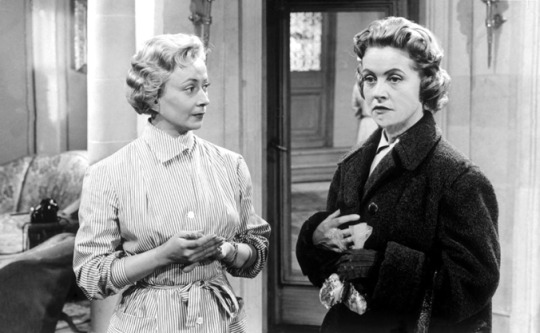
Après La Marie du port et La Vérité sur Bébé Donge, Le Sang à la tête offre à Gabin une troisième incursion dans l’univers de Georges Simenon, cet écrivain qu’il apprécie tant. C’est également l’occasion pour l’acteur d’élargir encore un peu sa palette de personnages, en incarnant un “self-made man” qu’une indéniable réussite sociale n’a pas rendu plus heureux. Considéré comme un parvenu par ceux qui l’ont connu simple docker, François Cardinaud est tiraillé entre deux mondes, problématique à laquelle Gabin ne s’était pas encore réellement frotté. [Collection Gabin – Eric Quéméré – mars 2006]
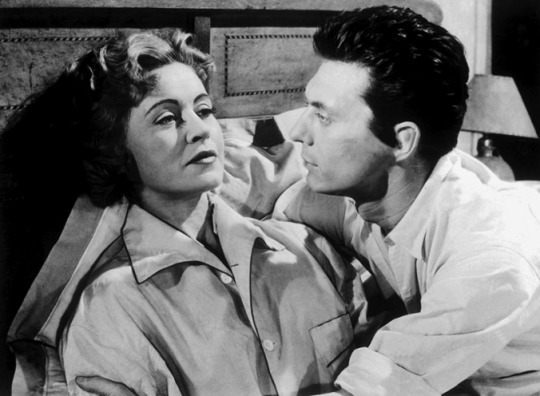
LE SANG À LA TÊTE – Gilles Grangier (1956) avec Jean Gabin, Renée Faure, Paul Frankeur, Monique Mélinand, Claude Sylvain, Henri Crémieux, Georgette Anys et José Quaglio
L’ambition sociale, confinant parfois à l’arrivisme, ne concerne d’ailleurs pas seulement son personnage, mais la plupart de ceux qui l’entourent : la gouvernante Mademoiselle, qui rêve d’un mariage d’argent ; les parents de Marthe, qui n’hésitent pas à mettre à contribution leur gendre ; et plus généralement, tous ceux qui, à La Rochelle, envient l’aisance de Cardinaud. Seule Marthe semble aspirer à autre chose que l’aisance matérielle – mais cette chose, son mari ne semble pas pouvoir la lui offrir…
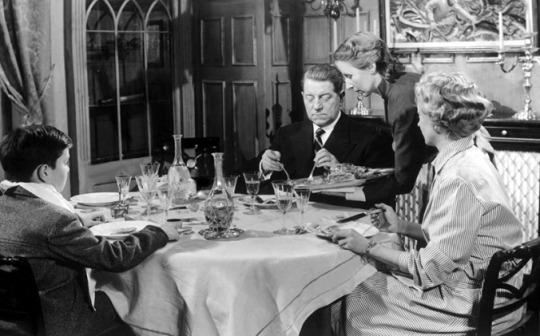
LE SANG À LA TÊTE – Gilles Grangier (1956) avec Jean Gabin, Renée Faure, Paul Frankeur, Monique Mélinand, Claude Sylvain, Henri Crémieux, Georgette Anys et José Quaglio
Le tournage du Sang à la tête débute le 15 février 1956, pour s’achever deux mois plus tard. Si les intérieurs sont filmés en studios à Paris, la plupart des extérieurs sont réellement tournés à La Rochelle. La présence sur le port d’une célébrité comme Jean Gabin fait évidemment sensation, mais grâce à la simplicité de l’acteur, qui s’est toujours refusé à jouer les stars, les rapports entre l’équipe et la population s’avèrent excellents. L’acteur, grand amoureux de la mer, apprécie de découvrir l’activité des quais, et de plaisanter avec les pêcheurs et les poissonniers. [Collection Gabin – Eric Quéméré – mars 2006]
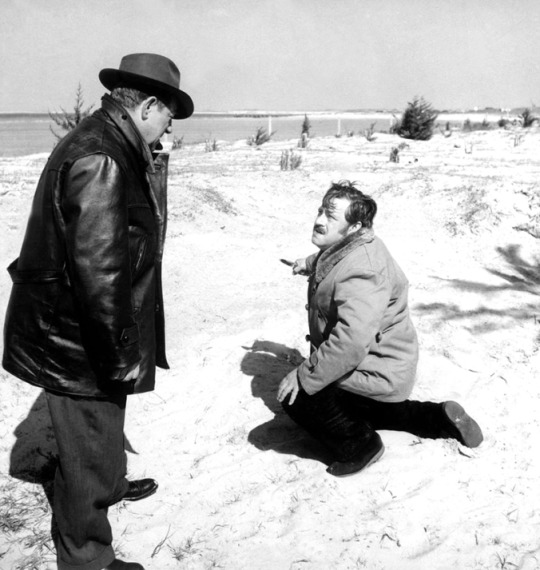
Nature à la ville comme à l’écran, droit dans ses bottes, l’acteur achève le film en toute sérénité, en compagnie d’une équipe ad hoc, dont l’assistant-réalisateur Jacques Deray qui fait aussi de la figuration – il campe Alfred le conducteur de car. Au contact du grand comédien, le futur réalisateur de Borsalino, en élève appliqué, prend de sérieuses leçons de cinéma : « C’était un seigneur, confie-t-il. Chaleureux mais pas très causant sur un plateau, il tirait son fauteuil à l’écart. Surtout pas de siège à côté de lui pour que personne ne vienne « l’emmerder”. Il était seul, et il regardait. On pensait qu’il était un peu indifférent à tout ce qui se passait autour de lui mais ce n’était pas vrai : il avait un œil, il observait. » Car les règles du cinéma français sont strictes, les horaires de travail coulés dans le bronze, de douze à dix-huit heures voire dix-neuf heures, six jours sur sept ; depuis longtemps rompu à ce rythme, Gabin n’a jamais failli : chaque jour, il débarque sur le plateau à midi “tête faite” c’est-à-dire maquillé et, selon sa propre expression “texte su” ! Quand ça ne tourne pas rond, il se met en colère, raison sans doute pour laquelle sur ce film, Grangier doit changer à quatre reprises de chef opérateur ; le premier, un Anglais, tombe malade, le second ne reste que huit jours, le troisième ne tient guère plus, c’est le quatrième qui achèvera le film. [Jean Gabin inconnu – Jean-Jacques Jelot-Bkanc – Ed. Flammarion (2014)]

LE SANG À LA TÊTE – Gilles Grangier (1956) avec Jean Gabin, Renée Faure, Paul Frankeur, Monique Mélinand, Claude Sylvain, Henri Crémieux, Georgette Anys et José Quaglio
Sur le plateau, Gabin prend également plaisir à donner la réplique à Renée Faure qui, dans le rôle de Mademoiselle, partage avec lui plusieurs scènes importantes. Après cette première collaboration réussie, les deux acteurs se retrouveront d’ailleurs pour deux autres films, Rue des prairies et Le Président. Après quelques semaines de montage Le sang à la tête sort à Paris le 10 août 1956. Si les résultats en salles ne seront pas comparables à ceux des grands succès connus par Gabin au cours des années 50, ils s’avèreront tout à fait honorables pour un film qui prend le risque de montrer l’acteur sous un jour moins glorieux que dans Touchez pas au grisbi ou French Cancan… [Collection Gabin – Eric Quéméré – mars 2006]

LE SANG À LA TÊTE – Gilles Grangier (1956) avec Jean Gabin, Renée Faure, Paul Frankeur, Monique Mélinand, Claude Sylvain, Henri Crémieux, Georgette Anys et José Quaglio
L’histoire
Ancien débardeur, François Cardinaud (Jean Gabin) est devenu, après trente ans de travail acharné, un armateur important de La Rochelle. Il a sauvé de la ruine Hubert (Henri Crémieux) et Charles Mandine (Léonce Corne), devenus ses associés. Ce dimanche-là, un cargo, L’Aquitaine, ramène Mimile Babin (José Quaglio), un garçon du pays qui n’a pas réussi à faire fortune en Afrique. Mimile retrouve sa sœur, Raymonde (Claude Sylvain), serveuse dans un café, et sa mère, Titine (Georgette Anys), marchande de poissons à la criée. Chez lui, Cardinaud attend que sa femme, Marthe (Monique Mélinand), revienne de la messe. Mais Marthe n’est toujours pas rentrée à l’heure du déjeuner. Inquiet, Cardinaud se rend chez ses beaux-parents, qui végètent dans un quartier pauvre de la ville. Ils ne peuvent le renseigner. Cardinaud va alors chez ses parents, des artisans vanniers, qui ne sont pas habitués à ses visites. Là non plus, aucune trace de Marthe. En ville, on murmure qu’elle a quitté le domicile conjugal pour de bon. La gouvernante des enfants, mademoiselle (Renée Faure), se voit déjà la nouvelle maîtresse de maison.
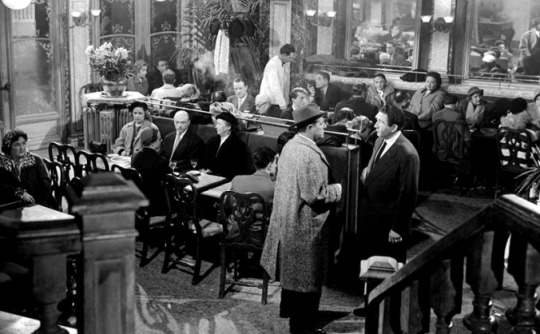
LE SANG À LA TÊTE – Gilles Grangier (1956) avec Jean Gabin, Renée Faure, Paul Frankeur, Monique Mélinand, Claude Sylvain, Henri Crémieux, Georgette Anys et José Quaglio
Deux jours plus tard, en l’absence de son mari, Marthe repasse chez elle, le temps de prendre une valise. Le soir, sur le port, Drouin (Paul Frankeur), capitaine de L’Aquitaine, apprend à Cardinaud que sa femme est partie avec Mimile Babin, son ancien amoureux. La ville est au courant, mais fait bloc contre l’armateur qu’on déteste à cause de sa réussite. Cardinaud arrache quelques renseignements à Raymonde et s’en prend publiquement à Titine Babin. Il retrouve la trace des amants dans un hôtel, mais arrive trop tard. De retour chez lui, Cardinaud y trouve son père, qui a reçu une lettre de Marthe expliquant qu’elle est mal à l’aise dans ce milieu de nouveaux riches. Se sentant délaissée par son mari, elle a besoin de renouer avec sa jeunesse. Cardinaud fait retirer sa licence à Titine Babin pour l’obliger à dire où est son fils. Il est dans l’île de Ré. Cardinaud prend le bac, mais il est suivi par Drouin, enragé contre Mimile qui l’a dénoncé à la douane. Les deux hommes en viennent aux mains, et Cardinaud assomme Drouin. Il arrive à l’auberge et y trouve Mimile, seul. Marthe est partie prendre le bac pour rentrer chez elle. Cardinaud réussit à la rejoindre et, sans un mot de reproche, revient avec elle à La Rochelle.
Les extraits
Fiche technique du film
Drame conjugal sur fond de lutte des classes, le film de Gilles Grangier contribue au renouvellement du registre de Gabin, deux ans après le succès de Touchez pas au grisbi. Adapté du roman magistral de Georges Simenon "Le Fils Cardinaud", il livre un portrait sans concession d'une certaine bourgeoisie de province. Drame conjugal sur fond de lutte des classes, le film de Gilles Grangier contribue au renouvellement du registre de…
2 notes
·
View notes
Text
Etiquette & Espionage

Let me just go ahead and say it: Gail Carriger’s YA Steampunk novel has just the best cover--the background design with the floral motif and gears, the model, the dress, and the random scissors...I can’t get enough of it.
I’ve been a fan of the Steampunk aesthetic for a while now--let’s just call it a remnant of my days studying Gothic literature in college. Replace monsters and repression with self-aware machines and inventions and you have Steampunk. While some ladies are still treated with kid gloves and taught to eschew all non-ladylike behavior in this genre, there is a rebellious streak that comes with the scientific innovation of the genre.
Sophronia Temminnick is an incorrigible teenager, and her poor mother is at her wit’s end with the girl’s climbing, tinkering, and snooping. Luckily for Sophronia’s mother, a chance encounter (that was naturally, perfectly orchestrated) with the proprietress of Mademoiselle Geraldine’s Finishing Academy for Young Ladies of Quality leads to an option for finishing school--meaning that Sophronia is out of her hair while being trained in the arts of womanhood. Sophronia, naturally, abhors the very idea. However, Sophronia soon learns that all is not quite as it seems at the finishing academy when their carriage is set upon by flywaymen, who seem to be after some sort of mysterious device called simply “the prototype.” Everyone else seems to know more about Miss Geraldine’s school than Sophronia, but no one will tell her what’s going on! It is quite frustrating for the girl.
When they finally arrive at Miss Geraldine’s academy, it becomes obvious that this a very special place. The academy itself is a giant hovercraft that floats above the moors--practically undetectable at any given time. Miss Geraldine is, of course, not the woman who came to collect Sophronia, but rather an unassuming woman who has no idea that school is actually a training academy for young spies. Sophronia is a “covert recruit”--a young woman with no family connections who is given very little information about the school while she is in her probationary period. Hijinks ensue when the prototype that the flywaymen are after disappears, and the school is targeted by those dastardly men. Sophronia is under the impression that a fellow student has hidden the device to sell to the highest bidder, and she embarks on a mission to find the prototype and return it to the school.
If all of this sounds a little too chintzy for your tastes...this book is probably not for you. It has fun Steampunk technology and a delightful cast of characters, but the language is overly cutesy and reads like a less sophisticated version of a Georgette Heyer novel. I mean that in the fondest sense, of course, but it can be a little bit too much at times. Take, for example, this passage:
Despite her beauty, she looks, thought Sophronia, a little like a crow. She stared down at her feed and tried to come up with an excuse for her behavior, other than spying on people. “Well, I simply wanted to see how it worked, and then there was this--”
Her mother interrupted. “How it worked? What kind of question is that for a young lady to ask? How often have I warned you against fraternizing with technology?”
Sophronia wondered if that was a rhetorical question and began counting up the number of times just in case it wasn’t. Her mother turned back to their guest.
“Do you see what I mean, mademoiselle? She’s a cracking great bother.”
“What? Mumsy!” Sophronia was offended. Never before had her mother used such language in polite company.
If the idea of a mechanical dog named Bumbersnoot or a mysterious group of gangsters called Picklemen immediately sets your teeth on edge, I suggest avoiding this book at all costs.
However, if you are up for a little bit of a romp, replete with werewolves, vampires, dirigibles, and cross-dressing Victorians, this may just be the book for you. It has a few madcap adventures (but far too many of those adventures involve outsmarting “mechanicals” which is just a bit boring), budding female friendships, and the barest hints of romance to come. It is tame, to be sure, and a little immature, but the protagonist is only 14. Sophronia’s naivete can be grating at times (especially when she meets a black man for the first time in her life...my god I almost tossed the book aside at that moment), but towards the end of the novel readers see more of the strong and compassionate young woman Sophronia will become. If the remainder of the series follows the Harry Potter structure of storytelling (that is, one book per school year), Sophronia and her friends will grow up and experience darker and more dangerous things. The plot was a bit unsophisticated and predictable, and it certainly has problematic elements, but it might be a fun read for a middle school girl.
3/5 Stars

#info 5425#etiquette and espionage#gail carriger#steampunk#book review#bookblr#ya librarian#books and libraries
8 notes
·
View notes
Text

MERCI HERBY
Par Jean Jean-Pierre
Le Nouvelliste | Publié le :25 juillet 2013
Si l'actualisation de soi (Self-Actualization), d'après le psychologue américain Abraham Maslow, c'est aspirer à devenir la meilleure version de soi-même, à manifester ses talents dans la vraie vie, il est évident qu'Herby Widmaïer a accédé au degré où il peut s'enorgueillir d'avoir atteint son actualisation tout en menant une existence utilitaire. Utile à son environnement immédiat. Utile à la société. Utile à son pays.
A 17 ans, Herby conçut et exécuta le son et le bruitage pour le film « Moi Je suis belle » (circa 1950), réalisé par son père, l'un des pionniers de la radio et du cinéma en Haïti, Ricardo Widmaier et Edouard Guilbaud. Le scénario du film était de Jean Dominique -il en avait été aussi le narrateur-. Plus tard, quand Herby rejoint les rangs de l'orchestre d'Issa El Saieh, nous avions pu découvrir un jeune et talentueux chanteur qui n'avait rien à envier aux Mel Torme, Frank Sinatra ou Tony Bennett. Exagérations, direz-vous. Ecoutez « Women in love » et « Choucoune », ou plus récemment « Fanm Peyi m ».
La vedette des stations
Suivant le même itinéraire emprunté (tracé conviendrait mieux) par son père, Herby introduira une myriade d'innovations dans la radio en Haïti. Citons-en quelques-unes :
"Jingles" d'identification :«La station des vedettes, La vedette des stations. Radio Haïti,». Certes, nous avions les Théophile Salnave (dit Zo), Jean Sorel, Gwo Djo, Jazz des Jeunes (cigarette Banda), Nemours Jean-Baptiste (Step Over, Energetic, Barbancourt) et Raoul Guillaume (Esso) qui faisaient de la pub enregistrée, mais c'était la première fois qu'on produisait en Haïti des spots promo d'identification avec de la musique originale. Quand il fonda Radio Métropole le 7 mars 1970, c'était l'échappée permanente d'un déversoir de créativité. « Nous aimons le compas, le jazz et la bossa... » (avec son ami Michel Desgrottes, assisté de l'orchestre Septentrional), « 129 sur votre cadran », « Bon week-end » et tant d'autres encore sont au départ de toute une tradition.
Bande FM : si l'Américain Edwin Howard Armstrong est le père de la bande FM (fréquence modulée), pour l'avoir inventée en 1933, Herby Widmaïer est le fier papa de sa diffusion en Haïti. Radio Métropole a été la première station commerciale émettant sur bande FM. Emission interactive : la première émission en Haïti conçue avec la participation directe des auditeurs à travers des lignes téléphoniques (en ce temps-là, il n'y en avait pas beaucoup en Haïti) fut produite par Herby Widmaïer. M. et Mme X fut présentée par feu René Toussaint et Iveline Sokol, devenue plus tard son épouse. Donc, Herby a été le premier à mettre en ondes les auditeurs et les reporters.
(Sois rassuré, Herby, que l'histoire ne te tiendra pas rigueur de l'utilisation abusive que nous faisons de ce système de communication au travers duquel nous débitons nos conneries et nos délations à longueur de journée.)
Reportage mobile : Herby inaugura le reportage mobile en Haïti avec ce programme matinal « Quand Port-au- Prince bouge » mettant en vedette l'original Bob Lemoine, un modèle dans la radio en Haïti. Ce programme avait aussi permis au public de découvrir les talents de ce technicien hors pair qu'est M. Roland Dupoux, membre fondateur de la station.
Nouvelles à chaque heure :je me souviens de cet excellent musicien Michel Déjean, ancien directeur du Choeur Déjean, qui était le propriétaire/opérateur de ce bar à la rue Bonne Foi et qui cavalait chaque 15 minutes avant l'heure à Radio Métropole, rue Pavée, à l'étage de la bonbonnièreMadame et Mademoiselle, pour présenter les nouvelles internationales « toutes les heures, 5 minutes avant l'heure ».
Ingénieur du son (studio d'enregistrement): entre 1955 et 1972, Herby a enregistré plus de 80% des albums réalisés par tous les orchestres haïtiens. Quant à ses prouesses de technicien de radio, d'amplificateurs, etc., n'en parlons pas.
« Music from 10 to 11 », une école sur les ondes.
Si la Dessalinienne était notre hymne national du matin, pour nous autres, jeunes musiciens de l'époque, le thème de l'émission de jazz « Music from 10 to 11 » -sur fond de rythme bossanova-, présentée tous les soirs par Herby lui-même, était devenu notre hymne du soir. A travers ce programme, cela dès la genèse de Radio Métropole, Herby élargissait nos horizons musicaux. Nous fûmes exposés aux Stan Getz, Dizzy Gillespie, George Benson, Ella Fitzgerald, Charles Mingus, Cannonball Adderly, John Coltrane, Charlie Parker, etc. Nous devînmes familiers des big bands de Duke Ellington, Woody Herman, Artie Shaw et de Count Basie.
Trois ans plus tard, avec son ami Gérald Merceron (un autre contributeur de la musique en Haïti), il nous a permis de voir évoluer sur scène (et de rencontrer) ces musiciens pour lesquels nous nous accrochions à nos cadrans (ainsi le chantait si bien Herby «129 on radio dial... »). D'autres, tels Lee Konitz, Jim Hall, Ron Carter, Jack de Johnette, Sarah Vaughn, Eumir Deodato, Herby Mann, s'ajoutèrent à la liste des illustres visiteurs. On rencontrait parfois ce dernier déambulant tout seul au Boulevard Jean Jacques Dessalines.
Herby n'était pas à son coup d'essai. Déjà en 1962, il encourageait David Young (un ami commun qui est parti) à faire venir en Haïti le grand Jazz saxophoniste américain Zoot Sims (de son vrai nom John Haley Sims). (Arrivés ici en Haïti, la première personne qu'ils se sont fait le devoir de visiter fut Mme Georgette à son Flamingo Bar -et lupanar- à Martissant).
« Excellence », est le mot que je préfère utiliser pour qualifier la carrière de Herby Widmaïer. Car toutes ses entreprises sont imprégnées de ce désir contagieux de surpasser le standard ordinaire. Il est indéniable que nous, qui grandissions en Haïti à cette époque, avions pleinement bénéficié de cette ambition de bien faire. De faire mieux. Quant à moi, je me suis servi de ce modèle pour me guider dans mes nombreuses productions à Carnegie Hall et au Lincoln Center. En plus, j'ai été vraiment honoré d'avoir pu inclure la voix d'Herby (Haïti de Marcel Sylvain son dernier enregistrement à date), dans mon CD « 1804-2004 Happy Birthday Haiti ».
Aujourd'hui, la station qu'il a créée reste encore une institution de référence qui priorise la qualité. Pas de nivellement par le bas. Pas d'«informations sous toutes réserves ». Il avait bien inculqué à ses fils Richard et Joël les principes primordiaux du medium. Les normes inéluctables de la déontologie de la profession.
Actualisation de soi ? Herby a utilisé son potentiel pour servir.
Nous sommes tous partie à un contrat social tacite qui stipule que nous devons laisser l'espace où nous évoluons mieux que nous l'avons trouvé. Herby Widmaïer peut être fier d'avoir honoré ses obligations contractuelles.
Merci Herby!
Jean Jean-Pierre
Source :
http://lenouvelliste.com/article4.php?newsid=119041
📸 http://lenouvelliste.com/images/nouvelliste/2013-07-15/herbyaupupitre.jpg
HAITI⭐LEGENDS
#HerbyWidmaier
#JeanJeanPierre
#LeNouvelliste
#MerciHerby #FM #RadioMétropole
#Jazz #radio #Tv
#haiti legends#haitilegends#iamgabrisan#haiti#konpa#jazz#haitian#music#compas#Herby Widmaier#herby widmaier
0 notes
Text
(( one time when urogi ran out of booze he snucked into georgttes witchy basement thinking she would have some in stored with all the herbs and berries
He found her shelf of potion getting giddy that he found some sort of "wine" he drank it
Couple hours past no sign of urogi georgette worried goes to find him her last resort would be checking her basement but no way in hell hed be stupid enough to do there right?
She found him transformed into a full blown griffon standing there all gracefully feeling more powerful in his new form now gaurding all there treasures ))

#also urogi as a griffon would be sick asf ngl#urogi#kny urogi#urogi kny#upper moon 4#hantengu clones#georgette mademoiselle
23 notes
·
View notes
Text

@georgette-mademoiselle your oc looks like this artstyle
Image credit: pinterest
10 notes
·
View notes
Photo
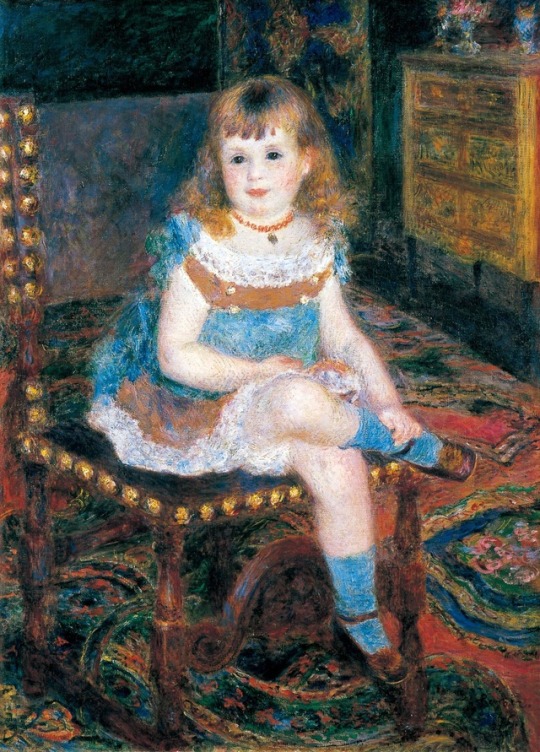
Mademoiselle Georgette Charpentier assise par Pierre Auguste Renoir 1876
2 notes
·
View notes
Text
New Post has been published on Pops-Fashion: tendencias y consejos para la moda femenina, moda masculina y productos de estilo de vida
New Post has been published on http://es.pops-fashion.com/los-espectaculares-estilos-en-los-vestidos-primavera-2017/
Los espectaculares estilos en los vestidos, primavera 2017.
Los fascinantes vestidos para la temporada, siguen deslumbrando y cautivando por sus diversos estilos con modernos diseños en estampados ó solidos, propuestas en cortes asimetricos, ideales para ese gusto casual, clásico y elegante, encuentra esa selección en nuestras tiendas y continua realzando la belleza femenina con un toque impecable.
Vestido en la imagen de cabecera
MAX&Co Vestido línea A de jersey de rayas
Precio Indicado € 179,00
Más información / Compra
Los vestidos de este artículo son las colecciones de estas tiendas virtual:
MAX&Co
Allsaints
Ralph Lauren
Guess
Desigual
Superdry
Asos
Comparte este artículo con tus amigos facebook, google+, twitter, etc.
Allsaints – Vestido midi de seda con estampado floral y a cuadros, cuello mandarín, cierre de botones, mangas tres cuartos, cinturón para ceñir, 100% seda.
Precio Indicado € 285,00
Más información / Compra
y cordones en el lateral de la cintura, cuello cruzado en V., sin mangas, czierre de cremallera oculto a la vista, ojales de metal, 100% poliéster.
Precio Indicado € 185,00
Más información / Compra
Allsaints – Fern Dress, Vestido de satén hasta media pierna con detalles de ajustes en la cintura que crean un efecto drapeado en la parte delantera, bajo asimétrico deshilachado, 100% poliéster.
Precio Indicado € 215,00
Más información / Compra
Ralph Lauren – vestido con à motif graphique, vestido sin mangas de ajuste, oculto cierre de cremallera, pliegues planchados en la cintura, falda plisada, totalmente forrado, exterior y el forro 100% poliéster.
Precio Indicado € 229,00
Más información / Compra
Raphl Lauren – vestido floral, sin mangas, cuello y espalda clara Zip con cierre de clip oculto en la parte trasera,
falda plisada, totalmente forrado, forro 100% poliéster, importado.
Precio Indicado € 169,00
Más información / Compra
Guess – VESTIDO CRUZADO, mezcla de viscosa elástica, detalle de cruce con aplicaciones frontales y posteriores, corte slim, Composición 55 % Viscosa, 43 % Poliamida, 2 % Elastano.
Precio Indicado € 119.90
Más información / Compra
Guess – VESTIDO BANDAGE CORDONES CRUZADOS, mezcla de viscosa elástica, escote en V, manga 3/4, corte slim, Composición 55 % Viscosa, 30% Poliamida, 15% Elastano.
Precio Indicado € 99.90
Más información / Compra
Desigual- Vestido Verde, manga corta con estampado de cenefas multicolores y cinturón para ajustarlo a la cintura, Composición 100% COTTON.
Precio Indicado € 99,95
Más información / Compra
Desigual- Vestido Tabi, sin mangas con un estampado de mandalas muy colorido, tela es de chifón, fina y suave con una caída fluida y elegante, composición 97% VISCOSE, 3% ELASTANE.
Precio Indicado € 75,95
Más información / Compra
Desigual- Vestido Sara, manga corta, estampado floral en contraste negro, material 65% VISCOSE, 35% POLYAMIDE.
Precio Indicado € 75,95
Más información / Compra
Superdry – Vestido Erin Racer, sin mangas de tipo patinadora con tejido de canalé, cuello alto y cremallera en la espalda, material algodón 70%, poliéster 30%, color rayas marino/blanco.
Precio Indicado € 74.00
Más información / Compra
Superdry – Vestido estilo camisola Festival Bardot, cuello Bardot clásico y tirantes ajustables, un panel de encaje por debajo del escote y un borde también de encaje en el bajo, una cremallera lateral, 100% Viscosa.
Precio Indicado € 65.00
Más información / Compra
Asos – Vestido largo tipo combinación Cassie Girl de Free People, tejido estilo satén, acabado liso y ligero Parte delantera escotada, abertura al muslo, tiras en la espalda, corte estándar se ajusta al tallaje real, 100% poliéster.
Precio Indicado € 129,99
Más información / Compra
Asos – Vestido a media pierna con hombro al descubierto de Moon River, chifón ligeramente texturizado con forro escote Bardot, diseño elástico fruncido en el cuello y cinturilla, volante, corte estándar, 100% poliéster.
Precio Indicado �� 109,99
Más información / Compra
Asos – Vestido largo veraniego con estampado de rayas de Faithfull, cuello bardot, diseño con hombros al aire, tapeta de botones, estampado de rayas, cxintura anudada, corte holgado, material 100% algodón.
Precio Indicado € 159,99
Más información / Compra
Más ropa, zapatos y complementos para mujeres, se pueden encontrar en estas tiendas virtual:
Zalando
Asos
La Redoute
Yoox
Superdry
AllSaints
Sarenza
Nike
G-Star Raw
Napapijri
Ralph Lauren
Boohoo
Deichmann
Milanoo
Addictochic
Stylepit
Modalia
Clarks
Swarovski ES
Gas Jeans
Edenly
MAX & CO
Merkal calzados
Coco Fashion
Oakley
Tous
Buylevard
Justfab
Intimissimi
Defshop
Desigual
Guess
Quick View
Wallis Vestido de tubo
€ 59.95
Wallis Vestido de tubo negro con estampado de flores.
Quick View
Vestido plisado de chifón
€ 24.30
Vestido plisado de chifón sin mangas con estampado de flores y bordado
Quick View
Vestido Mina
€ 30.00
Vestido Mina sin manga’s con estampado de flores.
Quick View
Superdry, vestido sin mangas
€ 63.00
Superdry, vestido sin mangas Neonomad Knotted
Quick View
Superdry Vestido Tencel Prairie
€ 90.00
Superdry Vestido Tencel Prairie Este vestido tiene falda de tipo patinadora y unos tirantes muy finos
Quick View
Superdry vestido
€ 66.00
Superdry vestido de medio largo Essentials twist
Vestido de medio largo Essentials Twist de Superdry para mujer.
Quick View
Superdry Vestido
€ 95.00
Superdry Vestido Sultry Scuba Pencil.
Vestido Sultry Scuba Pencil de Superdry para mujer.
Quick View
SILVIAN HEACH minivestido
€ 31.00
SILVIAN HEACH minivestido, punto jersey, estampado bicolor
Quick View
River Island vestido
€ 39.99
River Island vestido estilo camiseta con cinturón trenzado.
Quick View
Polo Ralph Lauren vestido
€ 169.00 € 84.00
Quick View
Pieces vestido
€ 30.99 € 25.99
Pieces vestido / Vestido pcBailey en azul
Quick View
Pepe Jeans vestido vaporoso.
€ 95.00 € 67.00
Vestido vaporoso. Cuello redondo con cierre de cordón con pompón. Estampado con tiras en contraste.
Quick View
mint&berry vestido informal
€ 64.95 € 51.95
mint&berry vestido informal con estampado de flores
Quick View
MAX&Co Vestido
€ 199.00 € 139.00
Max&co Vestido de tejido jacquard y organza
Vestido de tejido jacquard con motivo geométrico.
Quick View
MAX&Co vestido
€ 279.00 € 198.00
MAX&Co Vestido oversize en georgette de seda.
Quick View
Maison Scotch Vestido
€ 119.95 € 65.97
Vestido sedoso volantes de Maison Scotch.
Quick View
MADEMOISELLE R Vestido
€ 29.99 € 22.99
MADEMOISELLE R Vestido sin mangas a rayas.
Quick View
JUST CAVALLI Minivestido
€ 252.00 € 133.00
JUST CAVALLI Minivestido punto jersey, estampado multicolor, cuello redondo
Quick View
Guess vestido floral con nudo
€ 89.90 € 44.50
Guess vestido floral con nudo, Este modelo cautivador cuenta con un look que lo apuesta todo por la seducción
Quick View
G-Star Raw vestidos
€ 169.95 € 101.95
G-Star Raw Vestido inspirado en los trajes espaciales, diseñado para esculpir
Quick View
G-Star Raw vestido de denim
€ 179.95 € 125.97
G-Star Raw vestido de denim, inspirado en la ropa de trabajo, presenta una cinturilla que se puede retraer y uno bajo amplio y acampanado
Quick View
Anna Field Vestido largo
€ 29.95 € 26.95
Anna Field Vestido largo multi colores
Quick View
8 Vestido
€ 177.00 € 123.00
8 Vestido por la rodilla
0 notes
Text
Two anecdotes about Eugène de Beauharnais
Georgette Ducrest met Eugène when she was in attendance at Josephine's court during the winter and spring of 1810-1811. It seems that Eugene was with his mother for an extended period at that time, giving Mademoiselle Ducrest much opportunity to converse with him and observe him. Surprise! she liked him and admired him very much!
There will be more about Eugène in future posts. I've drawn these episodes from two sources, a book in my possession entitled Mémoires sur l'impératrice Joséphine, published in 2004 by Mercure de France; this is a re-edition of Georgette Ducrest's original memoirs published in 1828, though with a few abridgements; and a later edition of these memoirs published about three decades later, available on Gallica. The two editions are not strictly identical. I have used my book for the first anecdote and the Gallica edition for the second.
La princesse Borghèse donna un magnifique bal auquel assistait toute la famille impériale. Le vice-roi devait danser avec la reine de Naples ; il était déjà en place lorsque M. de Canouville se précipite vers l'orchestre et crie à Julien, qui le conduisait : "Une walse [sic]. - Monsieur, c'est une contredanse que l'on va danser . - Je veux une walse." Pendant ce petit colloque le vice-roi s'était approché, et observa que, pour suivre l'ordre établi jusqu'à ce moment, il fallait la contredanse. "C'est possible, Monseigneur, s'écria impétueusement M. de Canouville ; mais comme je walse avec la princesse Borghèse, je le répète, je veux une walse. Et tout de suite, obéissez, Julien. - Moi, Monsieur, dit doucement le vice-roi à Julien, je vous prie de jouer la contredanse." Ce qui fut fait, plusieurs atant entouré M. de Canouville, pour lui faire sentir combien sa conduite était inconvenante.
L'extrême modération du vice-roi fut connue promptement dans Paris, et augmenta l'affection qu'on lui portait, en prouvant qu'il savait allier les vertus privées à celles qu'il avait déployées dans les camps. Il se contenta d'opposer le sang-froid à une inconcevable folie, tandis qu'il pouvait d'un mot nui à celui qui ne craignait pas de se mettre ainsi en opposition avec lui.
Princess Borghese gave a magnificent ball which the whole imperial family attended. The Viceroy was to dance with the Queen of Naples; he was already in place when Monsieur de Canouville [Pauline’s squeeze at the time] rushed up to the orchestra and shouted to Julien, who was leading it: "A waltz.” "Sir, it is a contredanse that is about to be danced" "I want a waltz." During this little discussion the Viceroy had drawn near, and remarked that, in order to follow the order previously established, the contredanse was to be performed. "This is quite possible, Monseigneur," exclaimed Monsieur de Canouville impatiently; "but as I am to waltz with Princess Borghese, I insist on a waltz. And at once; comply, Julien." "I, Sir," said the Viceroy gently to Julien, "ask you to kindly play the contredanse." This was done; several people surrounded Monsieur de Canouville, trying to make him understand how unseemly his behaviour had been.
The Viceroy's extreme restraint was soon known through Paris, strengthening the affection people had towards him by demonstrating that he joined personal qualities to his military merit. He had gone no further than to remain composed in the face of unimaginable foolishness, when with a single word he could have discredited the one who had confronted him in such fashion.
Mémoires sur l'impératrice Joséphine, p. 260
Longchamps approchait. Joséphine demanda à mesdemoiselles Castellane, de Mackau. et à moi s'il nous serait agréable d'y aller. Avec toute la sincérité de notre âge, nous répondîmes que oui. Elle ordonna à M. de Monaco de faire préparer pour le beau jour sa plus jolie calèche, afin que nous y allassions d'une manière convenable. Elle nous fit présent de charmants chapeaux blancs à plumes tout pareils, et nous partîmes à quatre chevaux conduits à la d'Aumont par des jockeys à la livrée de l'Empereur ; deux piqueurs nous précédaient et deux autres nous suivaient. Arrivées au bois de Boulogne, nous attirâmes tous les regards, tant par l'élégance de l'équipage, la nôtre, que par la singularité de voir en public une voiture de Joséphine ; elle se distinguait de loin par un énorme parasol de taffetas blanc qui s'élevait du milieu de la calèche, et servait d'impériale. Mesdemoiselles de Mackau et de Castellane étaient très-jolies et madame Gazani fort remarquable ; aussi obtenions-nous beaucoup de succès. [...]
Le vice-roi à cheval vint nous parler ; il nous suivit longtemps la main appuyée sur la portière, et penché du côté de la voiture pour que nous entendissions mieux ce qu'il disait. Sa selle était apparemment mal attachée, car tout d'un coup nous vîmes le prince par terre. Nous fûmes fort effrayées, heureusement il n'eut aucun mal ; et il fut le premier à rire de sa mésaventure, qui n'avait, disait-il, pas d'inconvénient, puisque dans le moment de sa chute il n'y avait près de nous que d'ignobles fiacres, où sûrement il ne connaissait personne. "Autrefois, ajouta-t-il, je me fusse estimé heureux d'être salué par une personne assez favorisée du sort pour se trouver dans cette voiture, car j'étais trop pauvre pour y monter ; ce qui vous prouve, mesdemoiselles, qu'il ne faut jamais désespérer de rien." Ainsi que Joséphine il parlait souvent de sa mauvaise fortune, sans le moindre embarras ; ce qui faisait trouver bien juste celle si éclatante à laquelle il était parvenu.
Longchamps was drawing near. Joséphine asked Mademoiselle de Castellane, Mademoiselle de Mackau, and me, if we would like to attend. With all the sincerity of our youth, we answered yes. She ordered Monsieur de Monaco [Josephine’s equivalent to Napoleon’s Caulaincourt] to have her most beautiful carriage made ready for this fine event, so that we could travel there in fitting style. She made a gift to us of charming, matching white hats trimmed with feathers, and thus we rode off, our carriage drawn by four horses led by jockeys wearing the Emperor's livery, two piqueurs in front of us and two others behind. Once we reached the Bois de Boulogne we became the center of attraction, due to the elegance of our conveyance and to our own elegance as well, and also because of the rarity of seeing a carriage of Josephine's in public; in addition, this carriage was noticeable from afar because of the enormous parasol of white taffeta rising from its center, creating a sort of roof. Mesdemoiselles de Mackau and de Castellane were very pretty, and Madame Gazani very striking, hence we drew much notice. [...]
The Viceroy, on horseback, approached to chat with us; he rode along with us for quite a while, resting his hand on the carriage door and leaning towards us so that we might better hear what he was saying. It seems his saddle was poorly secured, because suddenly the Prince fell to the ground. We were much alarmed, but luckily he was not injured; he was the first to laugh about this mishap, which, he said, was of no consequence, considering that at the moment he fell there were only lowly cabs nearby, whose occupants were surely unknown to him. "In former times," he continued, "I would have considered myself fortunate to be acknowledged by anyone privileged enough by fate to sit in such a carriage as yours, as I was too poor to ride in one; which demonstrates to you, mesdemoiselles, that one must never despair of anything." Like Josephine, he often mentioned his former ill fortunes without the least uneasiness; this only made it seem fairer that he had achieved such brilliant success.
https://gallica.bnf.fr/ark:/12148/bpt6k6310101z/f76.item.r=georgette%20ducrest.zoom, p. 70
Why was Monsieur de Canouville’s behaviour so startling, even if overlooking his rudeness and arrogance? It seems that the order of dances at a ball was set in advance and not to be tampered with; Monsieur de Canouville was asking the equivalent of serving dessert before the roast goose and the joint of venison had been served at a banquet.
As for Eugène’s fall from his horse, what I would have most liked to witness was the scramble of the multitude of men employed in Josephine’s stables and accompanying the four ladies to Longchamps, each vying for the honour of properly resaddling that horse.
18 notes
·
View notes